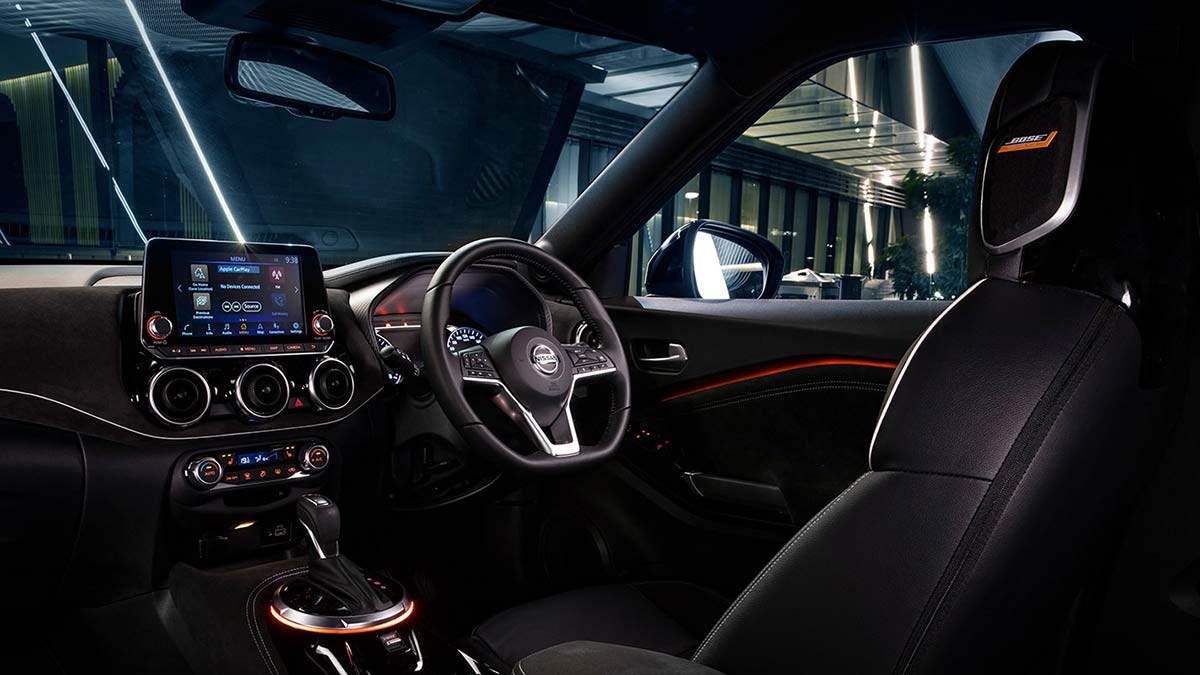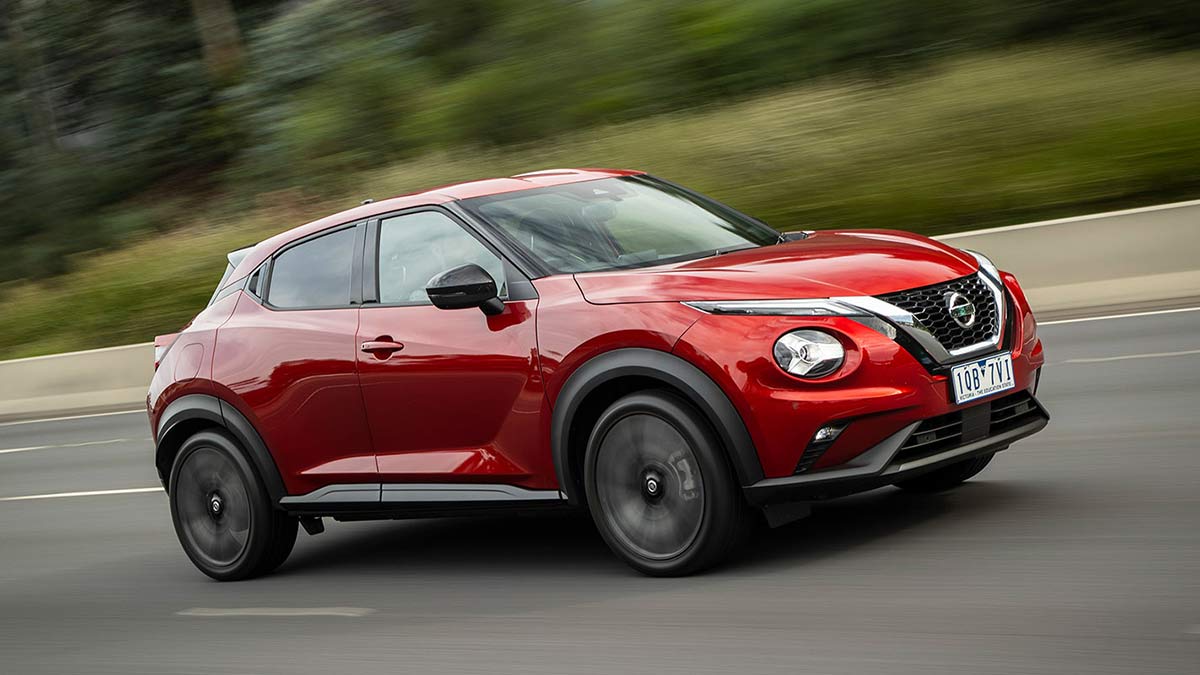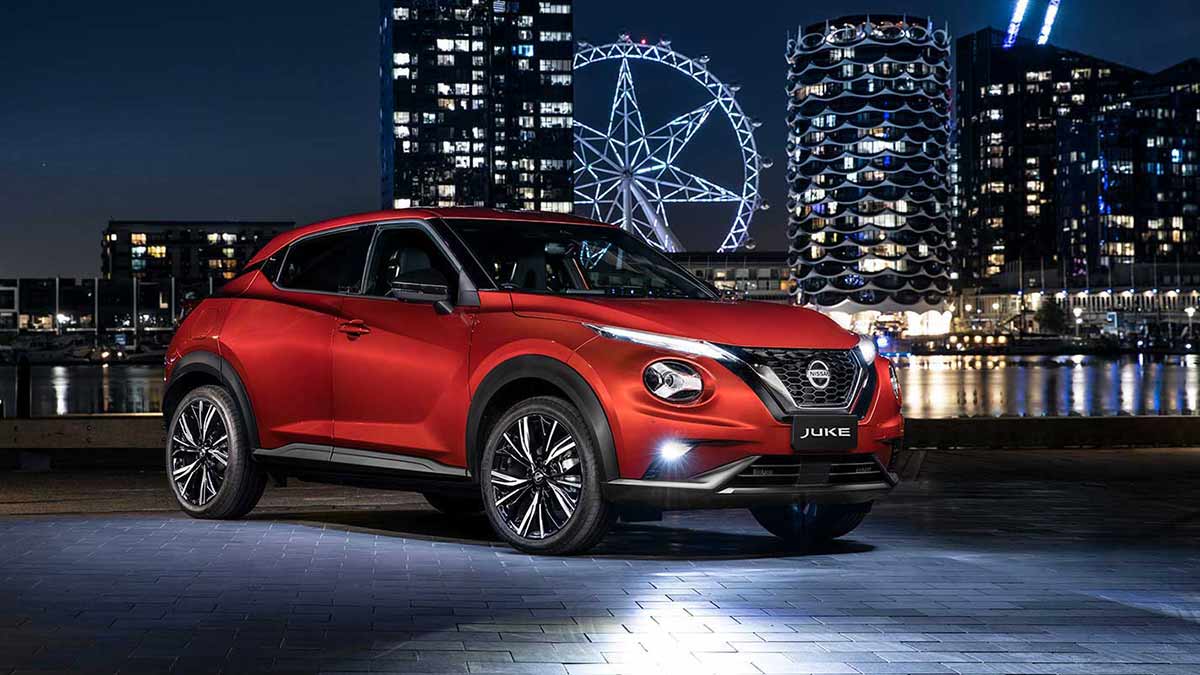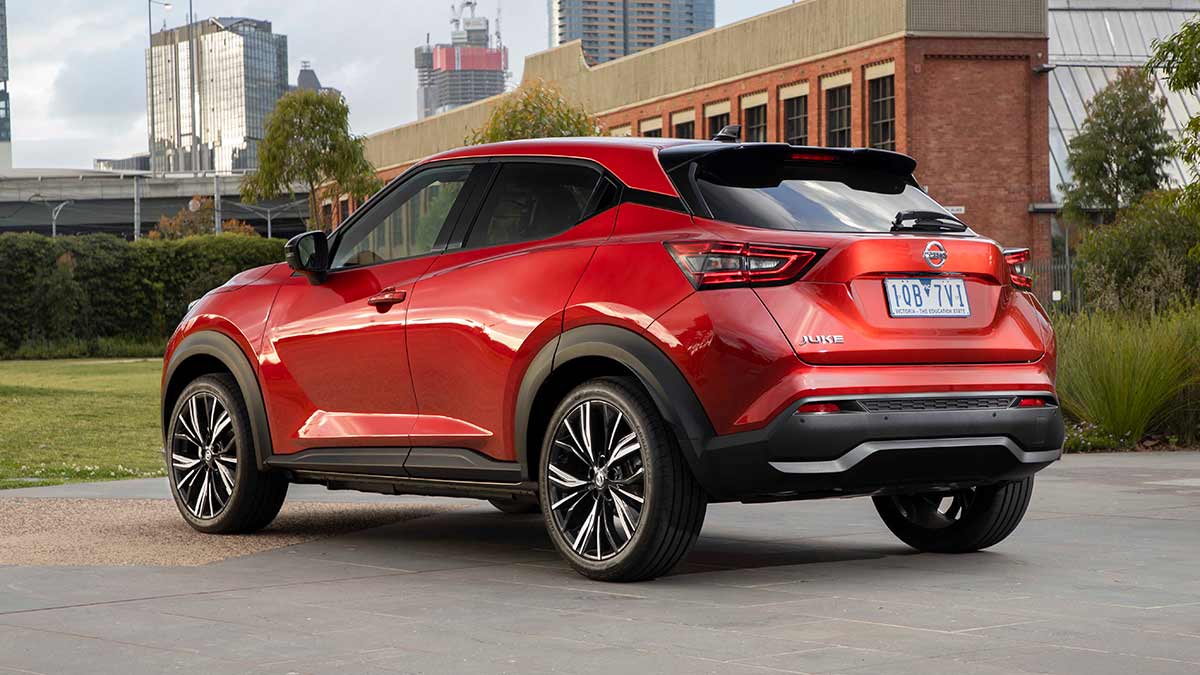The ninth-generation Toyota HiLux has arrived, bringing with it a futuristic forward exterior design, more safety and tech and the same rugged capability owners love. Will the updates tempt private buyers away from the Ford Ranger or are they just enough to keep fleets onside?
Nissan Juke Ti 2021 road test review

Nissan injected some much-needed pizazz into the compact SUV segment in 2013 with the launch of the first-generation Juke. It stood out from its rivals thanks to its polarising exterior design, but it never hit the sales highs of its larger sibling, the Qashqai. The all-new Juke arrived last year with an evolutionary design and significant improvements to interior space and practicality, as well as safety and on-board tech.
Thumbs up
- Arresting exterior design
- Handling
- Generous list of standard safety
- Comfort features
- Enormous boot
Thumbs down
- Turbo lag
- Average infotainment
- Busy ride on 19-inch wheels
- Noisy cabin
Price and positioning
Built at Nissan’s Sunderland plant in the UK, the new Juke is available in four model grades, all with the same three-cylinder turbocharged powertrain. The range kicks off with the ST at $27,990 before on-road costs, moving up to the ST+ at $30,740, the ST-L at $33,940 and the Ti tested here from $36,490.
Other popular light SUVs buyers might also consider include the Mazda CX-3, Hyundai Venue, Kia Stonic or Toyota Yaris Cross. The Juke is also up against a gaggle of funky Europeans, including the Ford Puma ($29,990 to $35,540), Volkswagen T-Cross ($28,390 to $31,390) and Renault Captur ($28,190 to $35,790). The Juke and Captur are built on the same Nissan-Renault Alliance CMF-B platform.
While the entry grades miss out on some comfort features, the Ti is packed with goodies, including an 8.0-inch multimedia display with Apple CarPlay/Android Auto, DAB+ digital radio, front and rear USB charging ports, satellite navigation and voice recognition. The Ti is fitted with a Bose eight-speaker audio system with speakers integrated into the front headrests, creating what Nissan describes as a “high-quality, immersive sound”.
Safety first
The Juke was awarded a five-star ANCAP rating in 2019, with a solid 94 per cent in the adult-occupant protection test.
Nissan has included a number of driver-assist features as standard across the Juke range, including autonomous emergency braking with pedestrian and cyclist detection, lane-departure warning, blind-spot monitor, rear cross-traffic alert, driver-attention alert and traffic-sign recognition.
The adaptive cruise control (standard on ST- and Ti) is well calibrated and accurately follows the speed of the vehicle ahead. The lane-departure system gently applies the brakes if you veer towards the line marking. The warning includes a buzzing vibration of the steering wheel which is a little surprising at first.
The inside story
Before we get to the interior, kudos to Nissan’s designers for the exceptional job they’ve done on the Juke’s exterior, taking the basic formula of the original and modernising it. It’s still attention-grabbing, but is more resolved.
The new Juke is 75 millimetres longer, 35 millimetres wider and 30 millimetres taller than the model it replaces, freeing up more occupant space. As a result, it doesn’t feel cramped and even the rear pew feels spacious.
The interior design is modern, but still familiar. Nissan has retained design cues from the original, like the circular gear-shifter housing. There is some evidence of cost cutting however, with parts from the previous model carrying over, including some of the switchgear, indicator stalks and door handles.
Nissan’s infotainment system does the job without excelling. The menu is logically laid out, but it’s not as modern as systems used by Hyundai/Kia, Mazda and Volkswagen. We were sceptical that the Bose headrest speakers might be a bit of a marketing gimmick, but they make a noticeable difference to the audio experience.
The Ti gains appealing black Alcantara (fake suede) inserts on the dash, armrest and doors and chrome flourishes throughout. The supportive leather/Alcantara front seats look like they’re borrowed from a sports car.
Storage is hit and miss with a big glovebox and enough room for bottles in the doors, but other bins are small. As mentioned, rear occupant space is surprising for a vehicle of this size, but it lacks rear air vents.
Another surprise is the boot space. It’s enormous for a light SUV. It can swallow 422 litres, increasing to 1305 litres with the 60/40 split-fold seats lowered. That’s only slightly less than the one-size-larger Nissan Qashqai’s 430-litre boot. A temporary spare wheel lives under the boot floor.

On the road
All Jukes use a 1.0-litre three-cylinder turbocharged petrol engine delivering 84kW of power and 180Nm of torque. It drives the front wheels only via a seven-speed dual-clutch automatic transmission.
There are some quirks to this powertrain. The turbo/dual clutch combo produces significant lag on take-off. The stop-start system doesn’t help and we switched it off every time we drove the car. That lag is also evident during low-speed driving and parking manoeuvres. If you’re in drive or reverse when parking, the vehicle can roll slightly in the opposite direction before the engine kicks in. It’s a common trait of small-capacity engines paired with dual clutches and while it’s not ideal, you learn to live with it.
Once up and running, the little three-pot engine is a sweetie. It loses some momentum with each gear change, making it jerky at lower speeds, but it reaches a sweet spot and reveals itself to be a playful powertrain. However, the low power and torque figures are apparent on steep inclines where the Juke starts to run out of puff and it’s not as responsive as the 1.0L VW T-Cross. The steering has a nice lightweight feel to it, but it still offers sharp turn-in.
Like the T-Cross, the Juke’s handling impresses, hugging corners and staying flat through tight twisty bends. The MacPherson strut front and coil spring rear suspension setup, coupled with front and rear stabiliser bars, aid dynamic driving. It’s a fun little car to drive on engaging roads. Roadholding is another strong point, with the Juke gripping the road well, although it’s a little skittish on unsealed road edges – nothing the traction control can’t handle.
The ride is a little busy on less than flawless roads, and the Ti’s low-profile tyres on 19-inch wheels mean sharper bumps penetrate the cabin. It’s not a deal-breaker, but we drove the base Juke ST on 17-inch hoops at the media launch and it has a more comfortable ride.
Noise, vibration and harshness levels have been improved for the new Juke, but it could do with more cabin insulation because road and wind noise are still evident.
Nissan’s official fuel use figure is 5.8 litres per 100 kilometres, but we recorded 8.8L/100km after a week of mixed driving.
|
Pricing |
List price: $36,490 before on-road costs. Price as tested: $36,490 before on-road costs. Model range: $27,990 to $36,490 before on-road costs. |
|---|---|
|
Drivetrain |
1.0-litre three-cylinder turbocharged petrol engine, seven-speed dual-clutch automatic transmission, front-wheel drive. Power: 84kW@5250rpm. Torque: 180Nm@2400rpm. Wheels: 225/45 R19. |
|
Fuel |
95 RON premium petrol, 46-litre fuel tank. Consumption: 5.8L/100km (government test), 8.8L/100km (RACV test). Emissions: 136g/km CO2. |
|
Standard safety |
Five-star ANCAP rating, reversing camera and rear parking sensors, rear cross-traffic alert, autonomous emergency braking with pedestrian and cyclist detection, lane-departure warning and lane-keeping aid, driver-attention alert, blind-spot monitor, traffic-sign recognition. |
|
Standard features |
Eight-speaker Bose ‘Personal Plus’ audio system, 8.0-inch touchscreen, Apple CarPlay/Android Auto, voice recognition, satellite navigation, leather/Alcantara seats, front and rear USB ports, heated front seats, power folding and heated door mirrors, auto LED headlights. |
|
Warranty |
Five-year/unlimited-kilometre warranty. Five years roadside assist. Capped-price servicing for the first six services. Service intervals every 12 months/20,000 kilometres. |




-name-close-up_1200x675.jpg)


